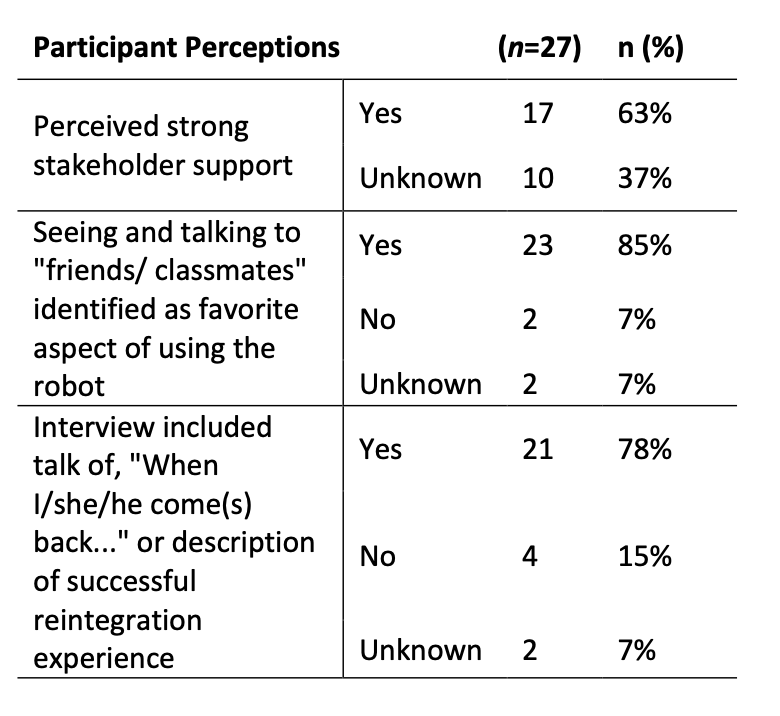Back
Background: Each year in the U.S. there are an estimated 15,780 children between the ages of birth and 19 years of age who are diagnosed with cancer. Many are also medically restricted to their homes each year due to symptoms, treatments, and recovery. Thus, they are consequently denied vital behavioral and developmental experiences fundamental to social connectedness and optimal development. A better understanding of the relationship between tele-technologies that facilitate person-to-person interactions and levels of social connectedness will allow us to develop innovative and comprehensive programs that improve quality of life experiences for childhood cancer survivors.
Objective: The objective of this study was to investigate the effects of using a tele-operated collaborative robot (telerobot) on social experiences in the physical world.
Design/Methods: A retrospective, cross-sectional analysis of robot-mediated experiences among children 5–18 years of age, with a cancer diagnosis who were using (or had used) a school-deployed telerobot, was used to examine the relationship between using a telerobot and child-to-child social experiences. Semi-structured informal interviews were conducted with child participants and their parents, educators, and peers. We applied Braun and Clarke’s thematic analysis to analyze the qualitative data. All participants used a school deployed VGo or Double 2 mobile telepresence robot (Figure 1).
Results: Childhood cancer survivors in our study experienced that, combined, cancer and social isolation made their situation extremely challenging. Strong social support from stakeholders was crucial to the success of robot-mediated social experiences. Data analysis of interviews (n=27) revealed two significant themes: 1) child motivation to use the telerobot during cancer treatments and recovery centered on retaining/establishing friendships, 2) telerobot use contributed to reintegration plans through participatory narratives that included the child with cancer and peers.
Conclusion(s): Robot-mediated inclusion may be beneficial for social connectedness and may also improve quality of life experiences during treatment and recovery from childhood cancer. However, results also revealed a strong desire to not “need” a robot and return to pre-cancer, in-person experiences. Future studies will evaluate robot-mediated engagement and social experiences in specific age groups to better understand child behavior and development needs during treatment and recovery from childhood cancer.
.png)

.jpg)
Children with Chronic Conditions
Children with Chronic Conditions 2
299 - Robot-Mediated Social Connectedness Maintains Friendships and Improves School Reintegration for Childhood Cancer Survivors
Saturday, April 29, 2023
3:30 PM – 6:00 PM ET
Poster Number: 299
Publication Number: 299.204
Publication Number: 299.204
Veronica Ahumada-Newhart, University of California, Davis, School of Medicine, Sacramento, CA, United States; Fred Meyers, University of California, Davis, School of Medicine, Sacramento, CA, United States; Daniel J. Tancredi, University of California, Davis, School of Medicine, Sacramento, CA, United States; James Marcin, UC Davis Health, Sacramento, CA, United States
.jpg)
Veronica Ahumada-Newhart, PhD (she/her/hers)
Assistant Professor
University of California, Davis, School of Medicine
Sacramento, California, United States
Presenting Author(s)
Background: Each year in the U.S. there are an estimated 15,780 children between the ages of birth and 19 years of age who are diagnosed with cancer. Many are also medically restricted to their homes each year due to symptoms, treatments, and recovery. Thus, they are consequently denied vital behavioral and developmental experiences fundamental to social connectedness and optimal development. A better understanding of the relationship between tele-technologies that facilitate person-to-person interactions and levels of social connectedness will allow us to develop innovative and comprehensive programs that improve quality of life experiences for childhood cancer survivors.
Objective: The objective of this study was to investigate the effects of using a tele-operated collaborative robot (telerobot) on social experiences in the physical world.
Design/Methods: A retrospective, cross-sectional analysis of robot-mediated experiences among children 5–18 years of age, with a cancer diagnosis who were using (or had used) a school-deployed telerobot, was used to examine the relationship between using a telerobot and child-to-child social experiences. Semi-structured informal interviews were conducted with child participants and their parents, educators, and peers. We applied Braun and Clarke’s thematic analysis to analyze the qualitative data. All participants used a school deployed VGo or Double 2 mobile telepresence robot (Figure 1).
Results: Childhood cancer survivors in our study experienced that, combined, cancer and social isolation made their situation extremely challenging. Strong social support from stakeholders was crucial to the success of robot-mediated social experiences. Data analysis of interviews (n=27) revealed two significant themes: 1) child motivation to use the telerobot during cancer treatments and recovery centered on retaining/establishing friendships, 2) telerobot use contributed to reintegration plans through participatory narratives that included the child with cancer and peers.
Conclusion(s): Robot-mediated inclusion may be beneficial for social connectedness and may also improve quality of life experiences during treatment and recovery from childhood cancer. However, results also revealed a strong desire to not “need” a robot and return to pre-cancer, in-person experiences. Future studies will evaluate robot-mediated engagement and social experiences in specific age groups to better understand child behavior and development needs during treatment and recovery from childhood cancer.
.png)

.jpg)
